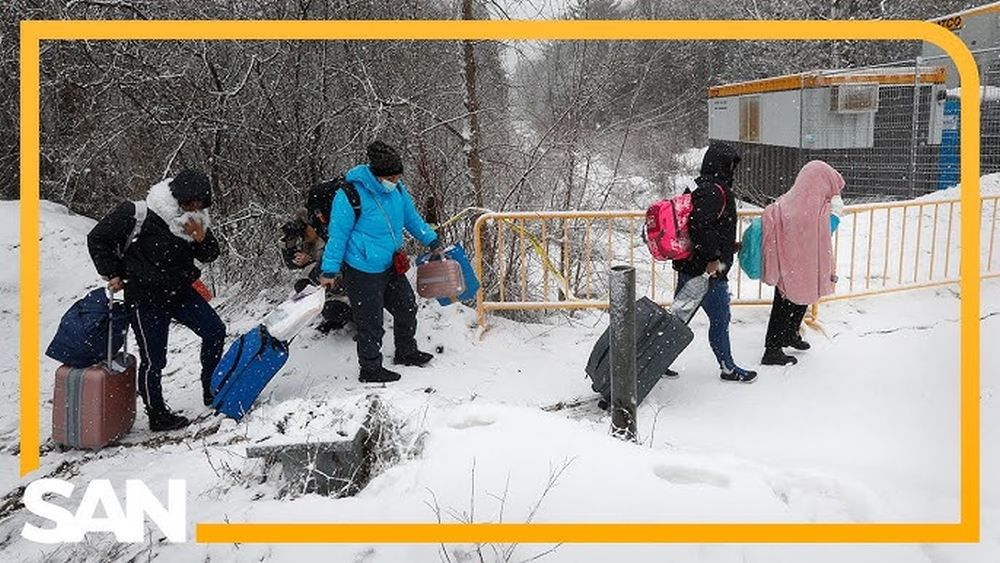The term “coyote” traditionally refers to individuals who smuggle migrants across the U.S.-Mexico border. Recently, however, Canadian human smugglers have adopted similar tactics, facilitating illegal crossings from Canada into the United States. This illicit activity has seen a surge, particularly targeting Indian nationals seeking entry into the U.S.
Emergence of Canadian “Coyotes”
In recent years, Canadian smugglers have been leveraging social media platforms, notably TikTok, to advertise their services. These “coyotes” promise “100% safe” and hassle-free journeys into the U.S., charging up to $5,000 per person. Their advertisements often feature the U.S. flag over wooded northern borders, accompanied by Indian music, aiming to attract potential clients. Despite efforts by platforms to remove such content, new accounts continually emerge, perpetuating the cycle.
Common Routes and Methods adopted to smuggle Asian immigrants to Canada or US
The smuggling routes typically commence in Canadian cities with significant South Asian populations, such as Montreal, Brampton, and Surrey. Migrants are transported by car to remote border areas, followed by a brief trek—often around 25 minutes—through wooded terrains to enter U.S. regions like upstate New York or Washington state. Smugglers provide maps to navigate past official checkpoints, usually guiding small groups of up to five individuals at a time.
Hiring Coyotees- Financial Implications, Personal Safety Hazards
The cost for these illicit crossings ranges between $4,000 and $5,000 per person. Some advertisements claim to offer the “cheapest in market” rates. Payment structures vary, with some smugglers demanding full payment upfront, while others propose “payment after reach” arrangements. It’s crucial to understand that engaging with these services not only involves significant financial risk but also legal and personal safety hazards.
These fees include:
- Transportation costs
- Document forgery
- Accommodation and food
- Bribery of officials
Recent Incidents Involving Human Smugglers
Tragic incidents have underscored the severe risks associated with human smuggling operations. In January 2022, the Patel family from India—comprising Jagdish Patel, his wife Vaishaliben, and their children Vihangi and Dharmik—attempted to cross the U.S.-Canada border near Emerson, Manitoba. Unprepared for the extreme cold, with temperatures plummeting to -35°C, the family succumbed to the harsh conditions and were found frozen to death just meters from the U.S. border. This heartbreaking event highlighted the perils of illegal crossings and the callousness of smugglers who prioritize profit over human life.
Human Smugglers admit the High payouts received
In a related development, Rajinder Singh, a convicted human smuggler, testified in November 2024 about transporting over 500 Indian migrants across the U.S.-Canada border over four years, earning more than $400,000. His testimony provided insights into the extensive smuggling network and the exploitation faced by migrants.
Risks and Dangers- Exploitation, Violence and abandonment
Utilizing the services of human smugglers carries profound risks. Migrants often face harsh environmental conditions, including extreme cold, which can lead to fatal outcomes. The tragic incident involving the Patel family underscores the dangers of attempting to cross the border during severe weather conditions. Additionally, smugglers may subject migrants to exploitation, violence, and abandonment, further exacerbating the dangers associated with illegal crossings. Even after paying large sums, there are no guarantees of successful entry or residency.
Legal Recourse and Protection against Human Smugglers
While victims of human smuggling can report their experiences to law enforcement agencies, the clandestine nature of these operations often complicates the recovery of funds or the pursuit of legal action against smugglers. However, victims of human smuggling can have recourse to following:
- Contact the Canada Border Services Agency (CBSA): Report any suspected smuggling activity to the CBSA hotline or online.
- Contact the Royal Canadian Mounted Police (RCMP): The RCMP investigates criminal activities, including human smuggling.
- Contact local police: If you have been subjected to abuse or exploitation, contact your local police.
Authorities in both Canada and the U.S. are actively working to dismantle smuggling networks and prosecute those involved. For instance, the Royal Canadian Mounted Police (RCMP) has initiated awareness campaigns to educate the public about the risks associated with human smuggling and to encourage reporting of such activities.
Protective Measures against Coyotees
To safeguard oneself from falling victim to human smugglers:
- Understand Immigration Laws: Familiarize yourself with Canada’s official immigration processes and requirements.
- Seek Official Channels: Apply for visas or immigration through official government channels.
- Be Wary of Unsolicited Offers: Be cautious of individuals offering to help you bypass immigration procedures.
- Verify Information: Do not rely on information from unofficial sources. Verify information with official government websites.
- Report Suspicious Activity: If you witness or suspect human smuggling, report it to the authorities.
- Do not trust promises of guaranteed entry: There are no guarantees when dealing with immigration.
- Document everything: if you have any interaction with a smuggler, document every interaction, including times, dates, locations, and any money exchanged.
Coyotes are a pressing Concern
The rise of Canadian “coyotes” exploiting vulnerable individuals seeking entry into the U.S. is a pressing concern. Engaging with these smugglers not only endangers lives but also carries significant legal and financial risks. It is imperative to utilize legal immigration avenues and remain vigilant against the deceptive practices of human smugglers.

